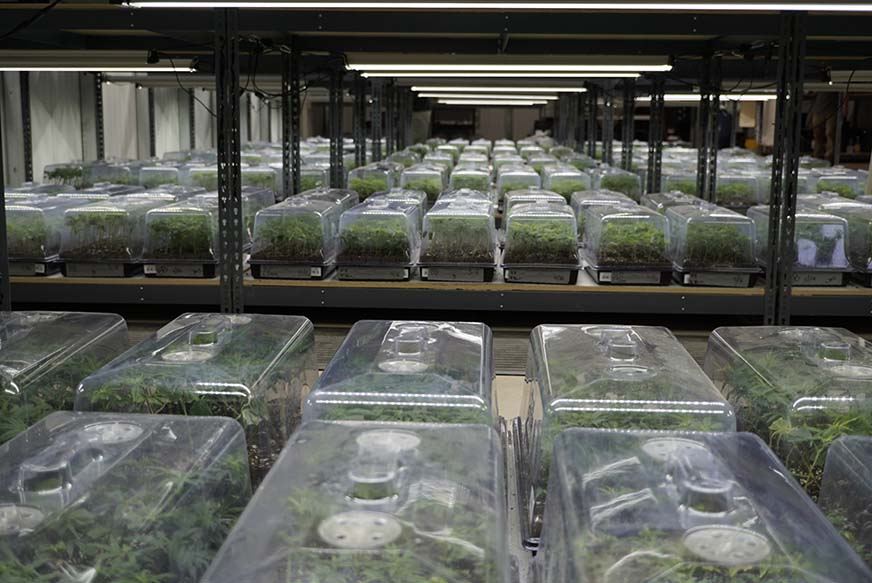The Hemp Farming Act of 2018 allows for widespread field cultivation of hemp, which opens significant opportunity for a range of agricultural practices. A Ceres Greenhouse allows cultivators to accelerate their hemp production with three distinct approaches. These are:
- Propagation
- Breeding & seed production
- Year-round operation
History and Considerations
The passing of the Agricultural Improvement Act of 2018, i.e. “the farm bill,” includes verbiage that moves hemp from a scheduled substance to an agricultural commodity. Effectively, this means that cannabis with less than .3% THC can legally be produced, processed and distributed within the United States.
This exciting new legislation opens a myriad of doors in a fledgling industry, one that was once thriving in the United States. Before America became a country, farmers throughout the colonies were growing hemp for industrial purposes – most notably for fiber to make rope and clothing. Before it was prohibited in 1970, the majority of American hemp was grown in Missouri, Illinois & Kentucky. The cannabis plant is highly adaptable to different climates, but grows especially well in temperate, semi-humid environments.
In today’s market, hemp is grown for food, fiber, and medicine. Though technically all under the same umbrella of the cannabis plant, there is a wide variation in genetics that allow different traits to be expressed. Hemp grown for fiber is a very different plant than hemp grown for cannabinoids. Cannabinoids are chemical compounds that the plant produces in its flowers, some of which have mental and physical effects when consumed or applied. One of the most significant in the current hemp market is cannabidiol, also known as CBD.

Propagation
Propagation is the act of creating new plants from existing ones, which is done through germination, tissue culture, or rooting stem cuttings. Currently, the majority of outdoor hemp cultivation is modeled similarly to tobacco; plants are started in a greenhouse (or indoors) before being transplanted to the field. This gives the farmer the advantage of a few weeks of growth before the planting season. At a certain scale, it makes sense for farmers to have their own greenhouse(s) to start plants for their field. Alternatively, propagation can be outsourced to a nursery. Most nurseries have their own genetic stock and are taking “clones” from mother plants. One way to use a greenhouse is to keep the mother plants in a vegetative state in the greenhouse, and start cuttings on racks under lights. Plants can be brought in to the greenhouse to begin the hardening off process by exposing them to sunlight. Ceres offers glazing options that allow the transmission of UV light and up to 96% PAR light.

Seed Production & Breeding
For cultivators looking to provide genetics to farmers, opposed to growing their own for production and harvest, a sealed greenhouse is an ideal facility. Heating, cooling and dehumidification are achieved through mechanical systems, creating a growing environment that is contained and controlled. The difference between seed production and breeding is that breeding results in new cultivars, whereas seed production is for the purpose of mass producing existing genetics. Both of these activities require a sealed environment to prevent cross-pollination from outside the greenhouse. The unique modular design of Ceres’ Greenhouses allows for climate simulation in isolated chambers. Plants can be grown under conditions starkly different than the local ones to prepare them for production in other parts of the world. This is especially important as the cannabis plant adapts quickly to its environment and expresses unique phenotypes. The ability to seal a Ceres Greenhouse is integral to a successful breeding or seed production operation.
Year round energy efficiency
Regardless of your primary intention for running a hemp growing facility, a Ceres Greenhouse will provide a stable growing environment year round, as well as low operational costs from reduced energy consumption compared to similar structures . The stability and predictability of the environment has an unquantifiable value. If you wish to have a reliable, perpetual business, then an insulated Ceres Greenhouse is well worth consideration. The benefits include: access to your own genetics by keeping plants alive year round, biosecurity and confidence in genetics from inhouse nursery, space for research and development, and flower production in the “off-season.”
Farmers and cultivators have many choices in approaching the hemp industry. Should I grow from seed or clone? Do I purchase starts or grow in-house? Do I want to grow acres or provide genetics? These questions are critical to consider, as every scenario has its benefits and disadvantages. For instance, clones are more reliable because of genetic stability, but are at higher risk of disease or plant health problems. Seeds are arguably more vigorous and put out a taproot, which is advantageous in field cultivation. Balancing all of these considerations comes with a necessary agility in a volatile industry, so we encourage designs that are both specific and adaptable to various approaches to growing plants.
In 2018, over 78,000 acres of hemp were grown in the United States. This number is projected to increase drastically with the favorable legislation and increasing market interest. A greenhouse is a strategic component in commercial hemp cultivation. If you’d like more information about our climate-specific solutions, please reach out!